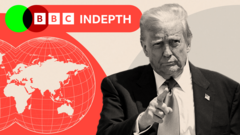In what can be described as a dizzying diplomatic week, U.S. President Donald Trump has taken significant steps that suggest a shift in his foreign policy approach. Amidst a global stage often marked by tension, his administration has negotiated various deals, showcasing a distinct preference for commerce over conflict. From sealing investment agreements in the Gulf worth $600 billion to negotiating the release of a U.S. citizen from the hands of Hamas, Trump's intentions seem to emphasize economic collaboration rather than ideological conformity.
His visit to Saudi Arabia illustrated this concept well, as he articulated a vision for the Middle East predicated on trade instead of chaos. However, underlying this mercantilist ethos is a stark absence of multilateralism and cooperation on global challenges like climate change, as Trump continues to emphasize a ‘America First’ strategy, distancing the U.S. from past attempts at collective governance.
Further complicating the picture, his administration has maintained a ‘none of our business’ stance regarding the recent India-Pakistan conflict, reflecting an unprecedented reluctance to engage in conflicts that do not overtly pertain to U.S. interests, although some pressure did ultimately come from Washington. The question of whether this reflects a coherent Trump doctrine or merely a series of reactive measures remains to be seen.
One of the most revealing aspects of this week’s events is the degree to which Trump's personal decisions are shaping U.S. foreign relations. Lifting sanctions on Syria—a move many in the State Department were initially against—demonstrated the risks and unpredictability that come when foreign policy is centralized in the hands of one man.
In the realm of trade, Trump's abrupt decision to cut tariffs on China after previously imposing punitive measures exemplifies his negotiation style of making bold initial demands followed by concessions. This pattern has left U.S. economic and diplomatic circles skeptical about his long-term strategy.
Moreover, his inconsistent policy towards the war in Ukraine highlights a problematic fluidity. What seemed to be a coordinated stance with European leaders was swiftly undercut by Trump’s suggestion for direct talks between Ukraine and Russia, showcasing a lack of clear direction in an ongoing conflict of grave international significance.
Despite the whirlwind of these diplomatic activities, skepticism abounds about their efficacy. The humanitarian situation in Gaza remains dire, peace efforts between warring nations seem elusive, and instability in global markets continues to loom large. In essence, while Trump’s current approach aims to redefine U.S. involvement overseas, it is still unclear whether this frantic diplomacy will yield lasting results or merely serve to mask deeper-rooted issues in international relations. The upcoming weeks will reveal whether these efforts translate into substantial change or simply reiterate historical patterns of limited effectiveness.

















